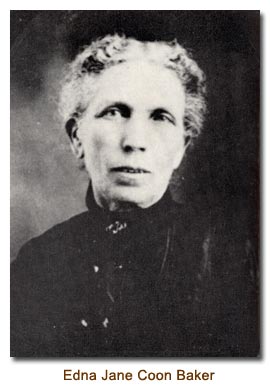Edna Jane Coon Baker
In the fall of 1848 several families of saints made temporary homes on the banks of a small stream in Pottawattamie County, Iowa. They had been driven from their homes in Nauvoo and were enroute to Utah, but were forced from lack of outfits and food and from the lateness of the season, to prepare for winter. Here, September 30, 1848, Edna Jane Coon Baker was born. She was the eldest child of Abraham and Elizabeth Wilson Coon. Like other pioneer families, they were in poor circumstances, and Mr. Coon worked at his trade of “Cooper” for nearly two years, therefore, not arriving in Utah until 1850.
Miss Edna Jane was then two years old and her early childhood was spent in Salt Lake City. At the age of eight years she went with her parents on the Carson Valley Mission. They arrived there July 1, 1856 and the next day, July 2, her mother died, leaving her father with a family of four small children, Mary, the baby, being but five months old. This was the greatest sorrow of Edna Jane’s life and it seemed she aged greatly because of the responsibilities placed upon her, as her mother’s dying request was for her to take care of the children. So humbly did she sense this duty, that she never left them and she cared for the young delicate babe so well that she was often called, “The Little Mother.” Throughout her life she lived faithfully to that request.
When the mission was abandoned, she returned with her father to Salt Lake City, where they made their home on the banks of the Jordon River near the “White Bridge.” This bridge was engineered by her father, Mr. Coon. She well remembered the incident of seeing Johnston’s Army crossing the bridge and of four of the officers coming to her father’s house to buy vegetables and of their paying one dollar in gold for two quarts of green peas that she had assisted in shelling. She also remembered the first stick of real candy she ever saw. She was twelve years old at the time.
When the work came for the Saints to move south in 1858, Edna Jane went with her father and family as far south as Spanish Fork. They stayed but a few weeks and then returned to their home on the river. She lied there and at their ranch at the west mountains, now Magna, during her girlhood days. Her schooling was limited on account of the many disadvantages; lack of books, insufficient clothing, and having to walk several miles in all kinds of weather.
In 1865 she went to Mendon where she met and married Albert Moury Baker, April 13th, 1865. From that time Mendon was her home. In those early days, sewing machines were very scarce and “Aunt Jane,” as she was familiarly known to all, possessed an aptness with her needle that was the envy of many. Many a tailored suit of clothes was the work of her hands. Here also may be mentioned, her serving for the dead. For years much of her time was spent in this noble work and also in making and taking care of the temple clothes for the Relief Society of the ward. When the society was first organized in the ward, she was sustained as the first secretary, which position she held for a number of years. Later she worked as a Relief Society teacher and did various kinds of public work.
“Aunt Jane” was of a genial and sympathetic nature, and spent much time caring for the sick, possessing considerable tact in nursing and helping others. Thee are but few families in the Mendon Ward who have not been helped by her service. She went into homes where there was sickness and death, regardless of disease or contagion, or danger to her own family. She was truly a ministering angel— sacrificing her own pleasure and impairing her own health for the good of humanity. In fact, we my truly say that her entire life was one of sacrifice and service. The loss of sleep and rest told heavily upon her in later years, yet she never grew cross, but was always of a jovial nature. Old and young were always welcome at Aunt Jane’s home.
She was the mother of eight children, four boys and four girls, all living at the time of her death, September 1, 1915. She was a loving and sympathetic mother. No sacrifice was too great for her to make for her children. She was a true later-day saint, a woman of great faith, and passed through many trying ordeals for her religious convictions, and her beautiful unselfish life will long live in the minds of all who knew her.